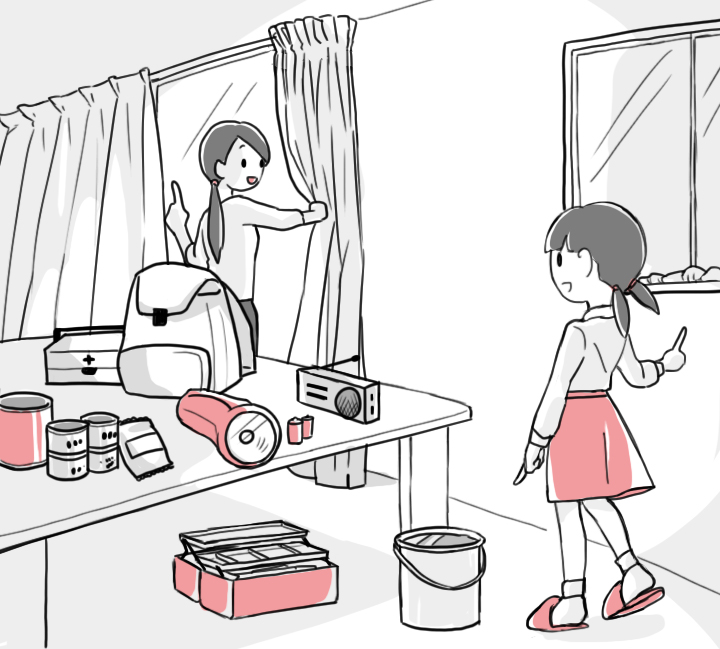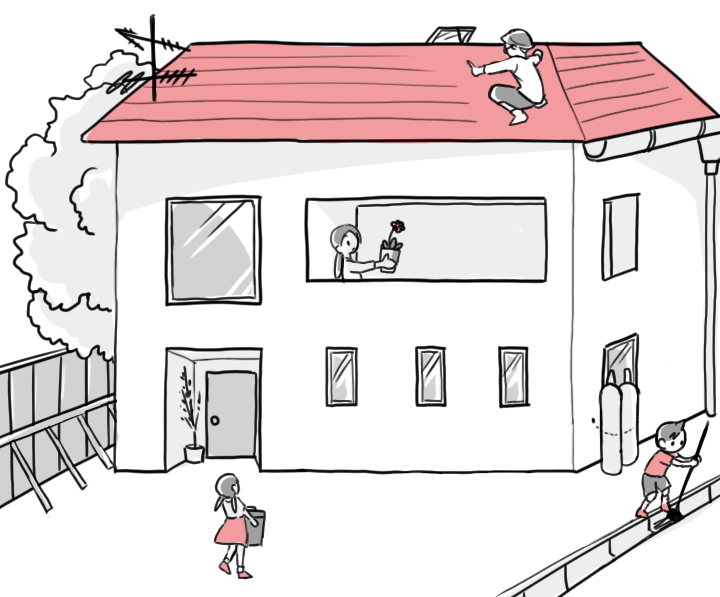Preparing for a Disaster - Typhoon/Flood
Typhoons and heavy rainfalls can cause severe damage. Be alert to disaster prevention weather information and take suitable preventive measures to reduce the possibility of damage.
Ensuring Safety in Your Home
Avoid leaving your home for nonessential and nonurgent reasons. Prepare beforehand for a safe prolonged stay at home. Also prepare for the possibility of extended power outages and water cutoffs.

1. Ensuring a safe stay at home
Prepare reinforcement tools including wooden boards, hammer, and nails for use if rain and wind are forecast to become stronger.
Draw the curtains or close blinds, etc. of windows. This is to reduce the risk of shards being blown into the room if a window is shattered.
If necessary, stuff rags or similar into window frames and other places where wind and rain may enter. Move important objects to higher shelves or the like as much as possible to prevent them from being damaged by flooding.
2. Have a suitable stock of necessities
Because it may not be possible to leave your home for an extended period, make sure you have enough drinking water and food etc. Especially in households with infants or sick persons, any special needs should be covered in advance.
Filling bathtubs and buckets or similar with water may be useful in case of a water cutoff.
Prepare a grab pack of emergency items to take with you in case you need to evacuate.
3. Check evacuation routes
Make sure you know beforehand where to evacuate to and what route you should take. Decide on the place and route in advance and share it with your family.
Use information material such as the “Hazard Map” published by your local municipality to check which locations in your vicinity including your home itself are at risk of water damage. When evacuating, avoid dangerous locations such as near rivers or the coast and choose a safe route.
Disaster evacuation sites and shelters
* This link opens the official Osaka City website.
Ensuring Safety Around Your Home
Make sure to check beforehand that there are no fragile items or spots around your house and secure any objects that may be blown off.

1. Make reinforcements to prevent damage
Check roof tiles, slates, etc. for looseness. Provide support for things that may be blown down, such as splints for trees, struts for wooden fences, etc.
Cover mud walls and similar with boards, etc.
2. Ensure proper drainage
Ensure that gutters, rain pipes and similar are clean and free from leaves, dirt, etc. which may cause blockage.
3. Fasten objects that may be blown away
Reinforce TV antennas and other objects as necessary. Fasten items such as laundry poles, flowerpots, items on a veranda, etc. with ropes or put them indoors. Also don’t forget to bring in trash cans, signs, and signposts and anything else that may catch the wind.
Acting Early is Crucial
When a serious weather event such as heavy rain or a typhoon is approaching, pay close attention to TV and radio reports and always try to get the latest information on the state of the weather, river water levels, etc. If a heavy rain or flood warning is issued, prepare for evacuation (official warnings will be announced on TV, radio, the Japan Meteorological Agency website, etc.).
According to the current conditions, the warnings and instructions listed below will also be issued by local governments through PA systems and disaster prevention radio. Even if an evacuation order has not yet been issued, it may be prudent to evacuate early, especially in the case of households with infants or aged persons, because evacuation may become difficult when the intensity of wind and rains has increased or after dark.
Prepare for evacuation / Start evacuation of elderly people
This is issued when the possibility of human injury increases. It encourages the evacuation of persons who may need time to evacuate or require special assistance, such as the elderly.
Other persons should prepare for evacuation or begin voluntary evacuation.
Evacuation advisory
This is the second highest emergency level behind “Evacuation order.” It advises all persons residing in a specific area to start evacuating to specified evacuation sites.
Evacuation order (emergency)
This is the highest emergency level. It directs all persons residing in a specific area to evacuate immediately.
Information for Foreign Residents of Japan Menu

